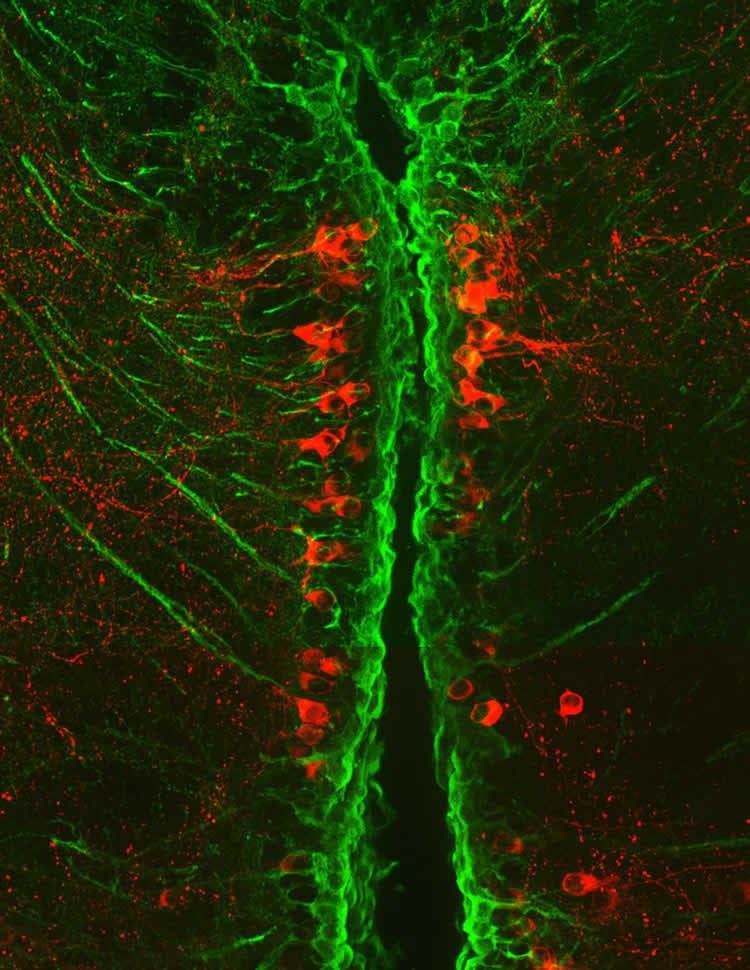Summary: Zebrafish study reveals how key dopaminergic neurons, which are damaged as a result of Parkinson’s disease, can be regenerated. Researchers report the immune system plays a critical role in the process.
Source: University of Edinburgh
Parkinson’s patients could be helped by fresh insights gained from studies of tiny tropical fish.
Research using zebrafish has revealed how key brain cells that are damaged in people with Parkinson’s disease can be regenerated.
The findings offer clues that could one day lead to treatments for the neurological condition, which causes movement problems and tremors.
Parkinson’s occurs when specialized nerve cells in the brain are destroyed. These cells are responsible for producing an important chemical called dopamine.
When these cells die or become damaged, the loss of dopamine causes body movements to become impaired. Once these cells are lost from the human brain, they cannot be repaired or replaced.
In zebrafish, however, dopamine-producing nerve cells are constantly replaced by dedicated stem cells in the brain, the researchers found.
The team, led by the University of Edinburgh, found the immune system plays a key role in this process. In some regions of a zebrafish’s brain, the process does not work, however.

Researchers say understanding the immune signals that facilitate the replacement of these nerve cells could hold vital clues to developing treatments for people.
The study, published in the Journal of Neuroscience, was funded by the Biotechnology and Biological Sciences Research Council and the Medical Research Council.
Dr. Thomas Becker, of the University of Edinburgh’s Centre for Discovery Brain Sciences, said: “We were excited to find that zebrafish have a much higher regenerative capacity for dopamine neurons than humans. Understanding the signals that underpin regeneration of these nerve cells could be important for identifying future treatments for Parkinson’s disease.”
Source:
University of Edinburgh
Media Contacts:
Jen Middleton – University of Edinburgh
Image Source:
The image is credited to Thomas Becker, The University of Edinburgh.
Original Research: Closed access
“Regeneration of dopaminergic neurons in adult zebrafish depends on immune system activation and differs for distinct populations”
Lindsey J. Caldwell, Nick O. Davies, Leonardo Cavone, Karolina S. Mysiak, Svetlana A. Semenova, Pertti Panula, J. Douglas Armstrong, Catherina G. Becker and Thomas Becker. Journal of Neuroscience 4 April 2019, 2706-18 doi:10.1523/JNEUROSCI.2706-18.2019
Abstract
Regeneration of dopaminergic neurons in adult zebrafish depends on immune system activation and differs for distinct populations
Adult zebrafish, in contrast to mammals, regenerate neurons in their brain, but the extent and variability of this capacity is unclear. Here we ask whether loss of various dopaminergic neuron populations is sufficient to trigger their functional regeneration. Both sexes of zebrafish were analysed. Genetic lineage tracing shows that specific diencephalic ependymo-radial glial progenitor cells (ERGs) give rise to new dopaminergic (Th+) neurons. Ablation elicits an immune response, increased proliferation of ERGs and increased addition of new Th+ neurons in populations that constitutively add new neurons, e.g. diencephalic population 5/6. Inhibiting the immune response attenuates neurogenesis to control levels. Boosting the immune response enhances ERG proliferation, but not addition of Th+ neurons. In contrast, in populations in which constitutive neurogenesis is undetectable, e.g. the posterior tuberculum and locus coeruleus, cell replacement and tissue integration are incomplete and transient. This is associated with loss of spinal Th+ axons, as well as permanent deficits in shoaling and reproductive behaviour. Hence, dopaminergic neuron populations in the adult zebrafish brain show vast differences in regenerative capacity that correlate with constitutive addition of neurons and depend on immune system activation.
SIGNIFICANCE STATEMENT
Despite the fact that zebrafish show a high propensity to regenerate neurons in the brain, this study reveals that not all types of dopaminergic neurons are functionally regenerated after specific ablation. Hence, in the same adult vertebrate brain, mechanisms of successful and incomplete regeneration can be studied. We identify progenitor cells for dopaminergic neurons and show that activating the immune system promotes proliferation of these cells. However, in some areas of the brain this only leads to insufficient replacement of functionally important dopaminergic neurons that later disappear. Understanding the mechanisms of regeneration zebrafish may inform interventions targeting regeneration of functionally important neurons, such as dopaminergic neurons, from endogenous progenitor cells in non-regenerating mammals.






